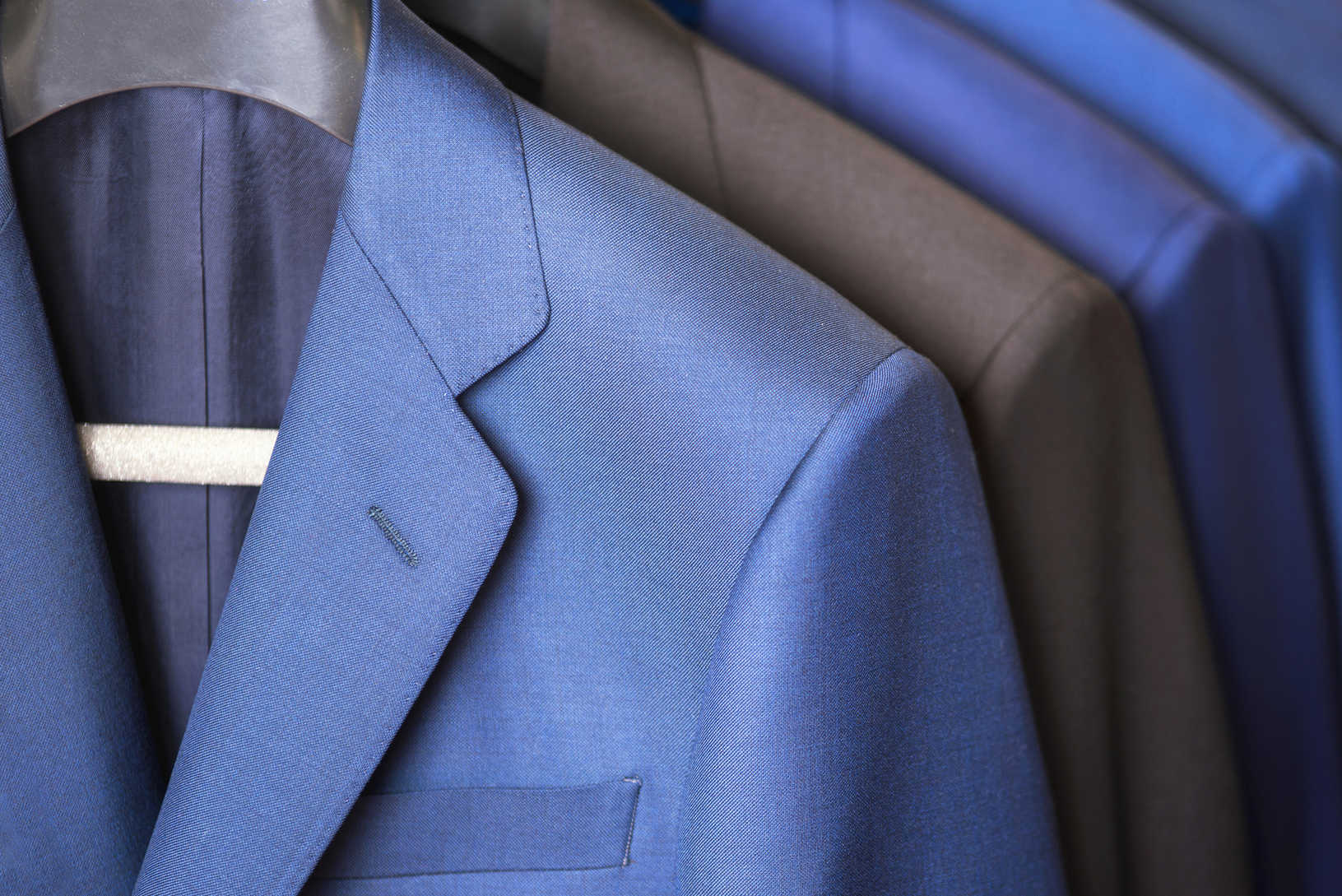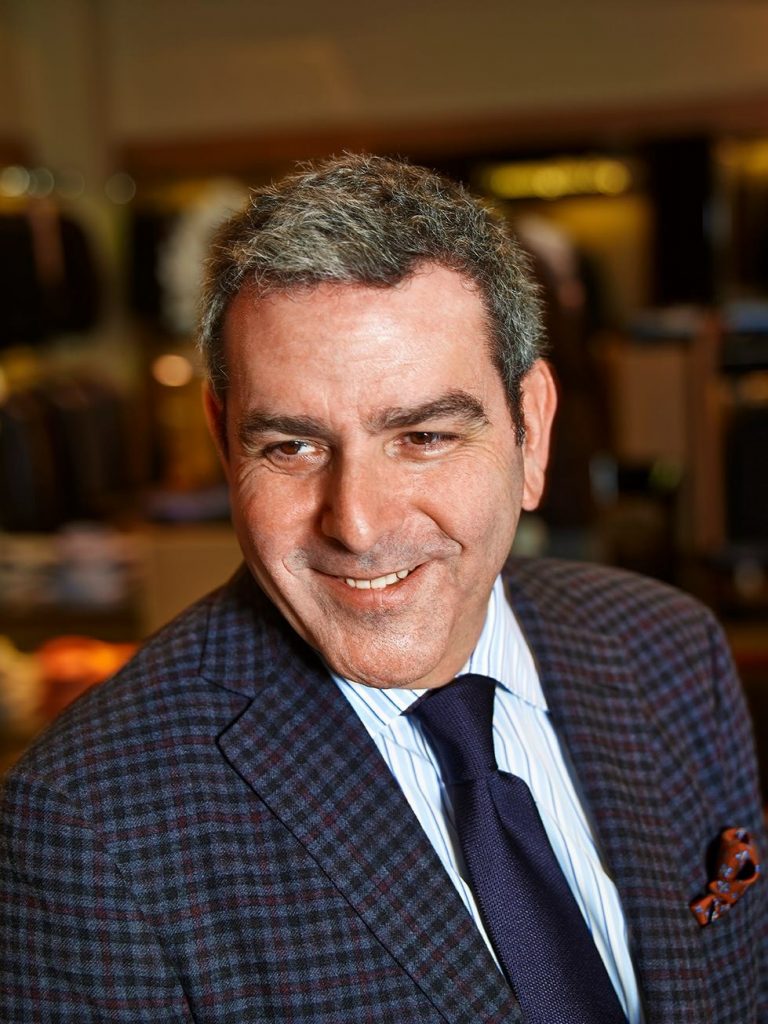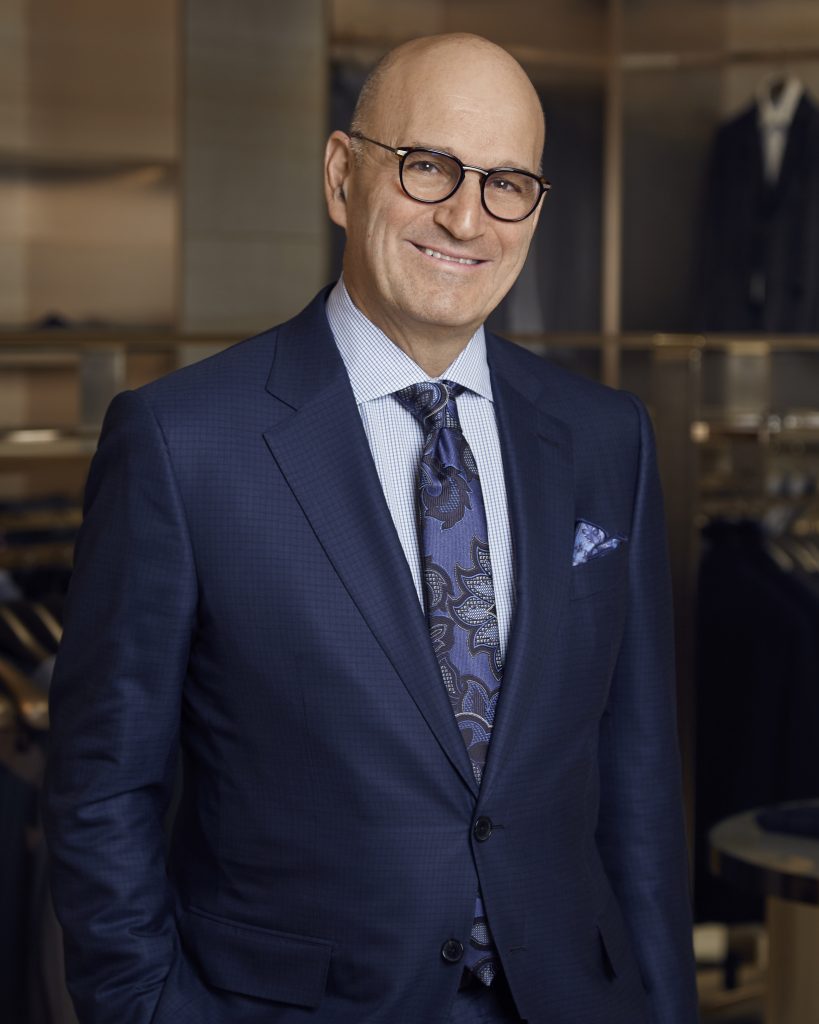RETAILERS DEBATE HOW TO REIGNITE AND REINVENT SUIT BUSINESS

For a recent virtual discussion MR produced in partnership with Project Digital, a panel of top tailored clothing execs spoke candidly about the post-pandemic state of suit business, and how to bring it back. What follows, edited excerpts from the conversation.
THE PANEL
Q: How’s business in tailored clothing and what’s trending? Would you consider adding lower pricepoints to attract more business from department store closings?
MURRY PENNER: With no need for men to go into the office or dress up, it’s a difficult time to be in the clothing business. We’re not selling enough of anything to detect a trend. Tailored represents about 50 percent of our business, much of which these days is made-to-measure. Our push going forward will be the fusion of tailored with sportswear. We’re not trading down as there’s no way to compete with excessive markdowns from the big stores. (Neiman’s is now our moderate-priced competitor…) Of course, we’re cutting back inventory and we’re already very lean. We have customers who come into the store and ask “Is this all you have?” to which we reply “Yes, but this is the best of the best.”
BOB MITCHELL: The pandemic has merely accelerated a downward trend that was already happening in suits. Tailored was more than 50 percent of our menswear volume; now it’s in the low 40s, maybe it will be 30 percent down the road. But I believe there will always be a place for tailored clothing in all of our markets.
Right now, sportcoats are selling better than suits: when we marked down our spring sportcoats to ridiculous prices, people bought them! But this is not a viable long-term strategy. Nor is bringing in cheaper goods: Samuelsohn and Munro remain our opening pricepoints.
I see the immediate future driven by sportcoats. But the overall market for tailored is frozen: there’s no demand so no point in stocking lots of inventory. Any increases might come from price escalation: guys buying fewer items but spending more on each. But bottom line, we need to control inventory and carry over (pack and hold) until demand for tailored clothing returns. For the first time ever, we packed and held spring suits. Going forward, we plan to aggressively market sportcoats, mixing them with sportswear throughout the store.
LARRY ROSEN: There’s no tailored clothing trend this fall and until offices and events open up, there’s not likely to be one. Weddings are driving some business but not enough; we’re still pretty locked down throughout Canada. I believe the suit will remain the armor a man wears for important occasions. The problem is occasions are much less frequent.
SCOTT SHAPIRO: I’m clearly an aberration in this group as I remain optimistic. Tailored clothing and related categories probably generate 90 percent of our volume. And just since Labor Day, I’m seeing some business come back. Sole practicing litigators are coming into the store, wanting a new suit. Financial execs tell me their customers are coming back so they want a new suit. I’m still betting on tailored staying the mainstay of our business.
ERICK DELEON: It’s hard to single out a fall clothing trend but we’re selling what we brought in.
We’re more a lifestyle store: 22,000 square feet including an interior design studio, lots of art, home accessories, furniture. Pre-pandemic, we were actively growing tailored with brands like Isaia, Brunello Cucinelli, Zegna, Canali, Eleventy, Boglioli, Hickey Freeman… We don’t carry lots of sleeves but we present a strong point of view in both sportcoats and suits. We don’t do much made-to-measure except for weddings: we’re forcing our customers to buy off the rack. We’ve always made it a point to include some intro pricepoints: Bonobos, Theory, John Varvatos, Paul Smith. In this way, we even sell high school kids who want to dress up for school photos.
Q: Wouldn’t a change in model give customers a reason to buy a new suit? After all, the slim suit has been around for many years now. And while designer runways are showing looser, drapier clothing, retailers seem reluctant.
MITCHELL: Until demand increases, a model change won’t help. Lighter, softer clothing maybe but even that’s still a small percent. Usage is just so low right now.
DELEON: I think the key is to be true to who you are while bringing in some new things. It’s not time to hit the panic button and this pandemic does offer the opportunity to try something different.
ROSEN: I don’t think a change in model would help: there’s at least a year in front of us before any semblance of normalcy. Like Mitchells, we’ve packed and held a good amount of suits and we’re merchandising fall selling floors by combining sportscoats with upscale sportswear.
MARK-EVAN BLACKMAN: I’ve seen the role of tailored clothing change tremendously in the past 15 years. If you look back 40 years, suits were the default wardrobe to indicate power. Today, suits are no longer required at church or at weddings; people with start-up money are not wearing suits. Maybe they’ll wear a softly tailored cashmere bomber jacket that costs as much as, or more than, a suit but young creatives don’t necessarily want to be perceived as ‘suit guys.’ It’s not a money issue, it’s a perception issue.
SHAPIRO: Before we buy spring ‘21, we need to first have ‘the conversation’ with our vendors. We need to negotiate support, back-up, partnerships, issues like how we can utilize their stock programs. For us to prepare for a worst-case scenario, we need vendor support.
With fall goods arriving and spring ’21 almost put to bed, we need some new looks so that when customers come in, we give them a reason to buy. We haven’t had a model change since 2008. When we first brought in blue tuxedos, we sold tons! We need some vision from the vendors. I believe that as independent specialty stores, if we get behind a new look, it will happen.
PENNER: I think that changing the model is premature: first we need customers wanting to wear suits. But pleated pants could work: we should be adding some interesting new tweaks to our sportswear mix. Our goal remains to lead customers to clothes that will help them look and feel their best. Only a small percent of our customers want to be challenged style-wise.
DELEON: I think a lot of what happens is generational. For the new generation with money, we break up the suit to show progression and versatility. So we’ll show one mannequin wearing the suit pant with upscale sportswear and another mannequin wearing the suit jacket for a totally different look. We show the progression and let the customer decide. Many young guys are first learning that nothing feels better than putting on a well-tailored piece.
Q: What if the industry got together to create a national ad campaign touting that message?
MITCHELL: An industry ad campaign won’t happen: we can’t even agree on a navy blazer! But we should all be promoting the jacket—be it a soft sportcoat, shirt jacket, outerwear piece—as the critical item in a wardrobe. Zoom calls have allowed people to regress. I can’t imagine what my grandfather would say about customers buying $1,000 jeans, $600 sneakers…but that’s what they’re buying. So tailored clothing will likely hibernate for a season or two; we have to hang tough.
Q: Final thoughts?
MITCHELL: I disagree that young guys want something totally different from their fathers. I’ve observed that young customers generally want the same Zegna-Cucinelli-Isaia looks as their dads; they want a relatively traditional suit that’s flattering. Some young guys are even more traditional than their dads…
ROSEN: I predict menswear business will be up slightly for fourth quarter, but that tailored will take a longer time to come back. We need to pivot toward the real opportunities and seek out new ideas in leisure dressing, above and beyond our traditional businesses.
PENNER: I agree that the future is luxury sportswear. The tailored clothing business will remain extremely difficult, especially suits, and I don’t see this business coming back before third or fourth quarter next year. But when customers regain interest in tailored clothing, they’ll want to see something new and exciting. Vendors need to re-think, re-size, re-merchandise, re-invent. They need to stop saying ‘this is how we’ve always done it.’
DELEON: I agree that business will improve for fourth quarter. And I’m optimistic that it will all come back for specialty stores who have a much better foot forward than department stores. The key is to stay true to your DNA and merchandise so that each brand has a distinctive DNA. You don’t need a blue blazer from every label.
SHAPIRO: I remain optimistic. If we survive this, we’ll be so much stronger and more relevant. In my downtown Chicago neighborhood alone, Brooks Brothers and Paul Stuart have vacated; Men’s Wearhouse and Joseph A. Banks are closed. And with the big specialty department stores closing doors in the suburbs, many of those customers will be venturing downtown.
But I strongly believe that vendors must do a better job directing business to our stores. With so many big store closings, we’re now more important to them than ever. If specialty stores stay loyal to their luxury brands, these brands should let their customers know that we carry their product.
—
To find out more about the panelists and to view the entire recorded discussion, click here.









Gentlemen, No one mentioned the US must be the leader in having a national policy to eradicate Covid 19 and any other potential virus. Right now the US has none and possibly some of you or your retail customers do not share this need. Our current direction and focus from the Feds have not shown any leadership. This has not and will not help our Tailored Clothing business at wholesale or retail. Think about it and be rational. This is not a word used anymore from Washington DC. Good Luck to All!
I agree with you David: a national policy makes so much sense! Let’s see what tonight’s results may bring…
I believe that the pandemic has only moved the needles in many industries quicker but many trends were already in place.
Ever since the first wave of “casual Friday” the trends in lifestyles were pent up beforehand.
The clothing business meaning suits and sports will never, ever come back as we know it.
When back in the 1970s I said I would like to see Chicago businessman wear a blazer with khaki or charcoal pants, a “ chambray work shirt with a tie, it was called herecy!
I had also said in the late 1990s that the trend away from sartorial has begun and unless editors and retail leaders teach men how to dress more casual in the workplace that men will go from wearing suits to polo shirts and chinos, many actually went to polo shirts with shorts.
Surely there is a new opportunity with new analytically designed clothes that can distinguish businessman with the same professionalism as did suits until the Changes began.
Bert Pulitzer
Great comments gentlemen. With or without Covid19 there is a shift if the work place and business dress with a few exceptions. Scott Shapiro notes his litigious legal clientele; noted and not to be forgotten. There are other cache’s of clientele in similar want/need for tailored clothing. The fashion trend will simply be “showing up in person” for awhile. Nothing close to rocket science thinking. What we have is what we will be for awhile as far as fashion and how we all provide the experience will make the difference.
My experiential evidence is the custom shirt business which is viable and makes new looks possible without dramatic changes in the tailored clothing. Here in lies the experience. Freshness where you can find it. Hope all you guys have vendors that can provide and customers to share it with.
Remember there was the roaring 20’s after the 1918 Spanish Flue.
Here’s to the Roaring 2020s! Thanks Paul for sharing your thoughts.
Karen after reading and watching your podcast with your selected panel of high end menswear professionals, which was very educational and well done on your behalf, I was inspired to respond to you.
The question that I have is how many more high end merchants are there in North America and what percentage do they make up in total of the menswear industry as a whole?
There are other levels of specialty menswear businesses which are called moderate to better and moderate to budget which do take up another big portion of the industry. Some of the same questions asked to the high end stores may be answered a little differently by the other merchants not selling $1,000 items or $1,200 sport coats and made to measure.
The menswear business in all levels will not go anywhere. It will always continue to evolve with different trends even in and after this Pandemic.
The main key to survival for the stores itself is to have a financial cushion to ride out the wave. Of course, the merchants still must have the desire to compete with the competition of other stores, vendors, outlets and online sites and have all the financial responsibility.
If and when you lose the desire to deal with all the above, then it is time to retire and move on with all your wisdom and knowledge that you received from our beloved menswear and footwear industries.
Knowing your customer and being grateful for them and letting them know you appreciate their loyalty and business will help stores last into many generations to come with satisfied customers.
Hi Gio, I have not forgotten the more moderately-priced specialty stores and some of them appear to be doing okay. I’m told that this past spring, high school kids were buying opening-priced suits for graduation photos, even where proms and graduations were cancelled. Grooms and groomsmen bought opening-priced suits for wedding photo ops, even when large wedding celebrations were postponed. Unfortunately, on the whole, these moderate specialty stores are fewer in number than previously, mostly because for the past decade or more, they’ve needed to compete with discount stores, clothing chains and constant price promoting in department stores. The luxury stores, on the other hand, have been able to compete (until the pandemic) on exceptional service, in-house alterations and the finest product in the world.
I pray those menswear warriors who remain (luxury and moderate) will be able to sustain enough business to make it through the next season or two. I remain encouraged by their creativity and stamina throughout these trying times. But I agree with you: once the passion is gone, it’s time to move on. xxKAG
–